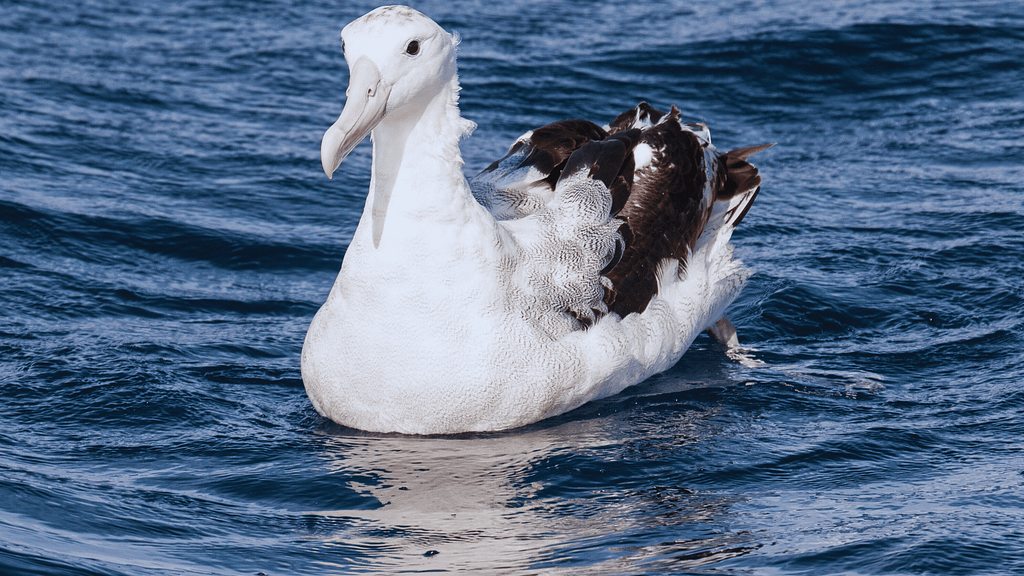Are you seeking in-depth details regarding the magnificent wandering albatross? There’s nowhere else to look! This article explores every aspect of these intriguing seabirds, including their size, height, weight, habitat, lifespan, and feeding habits. It also includes eye-catching photos to enhance your learning.
Nestled among the wide expanses of the southern oceans, the wandering albatross is a magnificent species with an impressive wingspan and exquisite flight.
These seabirds, famous for their ability to fly silently for hours, are particularly beloved by scientists and environment lovers. The wandering albatross captures the attention of everyone it comes into contact with, both with its distinctive physical characteristics and their unusual actions.
In this article, we provide in-depth information on the size, preferred habitats, feeding habits, and many other facets of the life of the wandering albatross.
This thorough guide tries to satiate your curiosity and offer insightful information about the fascinating world of the wandering albatross, whether you’re a budding ornithologist seeking knowledge or fascinated by the wonders of nature.
Read Also: 5 Unique Small Black Bird With White Belly ( Facts & Info)
Wandering Albatross Origin And History

The Wandering Albatross (Diomedea exulans) is a magnificent seabird known for its large wingspan, long-distance flying, and beautiful gliding ability. Here is a detailed discussion of its genesis and history:
Origin: The wandering albatross is part of the Diomedeidae family, including numerous other huge seabird species. It originated in the Southern Hemisphere, where it lives largely in the open ocean and on remote islands.
It is most widespread in the Southern Ocean, which extends from Antarctica to the subtropics.
Evolutionary History: Albatrosses are among the oldest seabirds, with fossil evidence dating back 50 million years.
Their evolutionary history is entwined with the shifting landscapes of the world’s oceans, as they have adapted to varied environmental circumstances over millions of years.
Discovery and Naming: The wandering albatross was first documented during the Age of Exploration when European sailors ventured into the southern seas.
It was named “wandering” due to its habit of soaring vast distances across the open ocean. In the 18th century, Carl Linnaeus gave the species its scientific name, Diomedea exulans.
Cultural Significance: Wandering albatrosses first arose during the Age of Exploration, when European sailors explored the southern waters.
It was called “wandering” because it frequently flew long distances across the open ocean. In the 18th century, Carl Linnaeus gave the species its scientific name, Diomedea exulans.
Conservation Status: Despite their extraordinary adaptations for life at sea, wandering albatross populations are under constant threat in the contemporary period. These include habitat degradation, overfishing of their target species, pollution, and accidental bycatch in fisheries.
As a result, the International Union for Conservation of Nature (IUCN) has classified the wandering albatross as vulnerable, emphasizing the critical need for conservation measures to safeguard this iconic seabird.
Read Also: 5 Unique Purple Birds: You’ve Never Seen Before
Wandering Albatross Size
These extraordinary physical traits make the wandering albatross one of the most unique avian species, perfectly suited to live in the open ocean.
Its wide wingspan and superb flying powers enable it to travel long distances while looking for food and navigating the windswept plains of the Southern Ocean.
The wandering albatross (Diomedea exulans) is known for its massive size, notably its wingspan, which ranks among the largest bird species. Here are a few crucial measurements:
Wingspan: The wandering albatross boasts one of the largest wingspans of any bird, ranging from approximately 2.5 to 3.5 meters (8 to 11.5 feet).
This vast wingspan enables the bird to soar effortlessly over enormous distances across the open ocean, utilizing air currents to glide for extended periods without flapping its wings.
Body Length: Besides its remarkable wingspan, the wandering albatross has a substantial body size. On average, adults measure around 1.1 to 1.35 meters (3.6 to 4.4 feet) from beak to tail.
Weight: Despite its large size, the wandering albatross is relatively lightweight in terms of its dimensions. Adults typically weigh between 5 to 12 kilograms (11 to 26 pounds), with males generally being larger and heavier than females.
Wandering Albatross Height

The wandering albatross’s height typically refers to its standing height when on land, measured from the ground to the top of its head or back. While specific measurements may vary slightly among individuals, the standing height of an adult wandering albatross is generally around 1 to 1.2 meters (3.3 to 3.9 feet).
It is crucial to highlight that the wandering albatross spends most of its time at sea and is best known for its soaring flights rather than standing erect on land. When they come ashore to procreate or rest, their height may be measured, giving us a sense of their physical size.
Read More: I Found 11 Unique Black Birds in Florida: Images & Details
Wandering Albatross Weight
The wandering albatross, also known as Diomedea exulans, typically weighs between 5 to 12 kilograms (11 to 26 pounds). This weight range can vary slightly depending on age, sex, and individual variation within the species.
Male wandering albatrosses tend to be larger and heavier than females, with some males reaching the upper end of the weight range. Juveniles and subadults may have lighter weights compared to fully mature adults.
Wandering albatrosses have adapted to their surroundings despite their size. Thanks to their lightweight bodies, they can fly across the open ocean over great distances efficiently.
Wandering Albatross Habitat
The wandering albatross lives largely in the Southern Hemisphere, on huge open oceans and lonely islands. Its habitat spans the Southern Ocean, from Antarctica to subtropical regions.
These majestic seabirds spend most of their lives at sea, often foraging thousands of kilometers from land. They are perfectly suited to life in the open ocean, relying on strong winds and currents to glide smoothly across great distances.
During the breeding season, wandering albatrosses return to select Southern Ocean islands to mate and raise their young. They seek islands with ideal nesting locations, such as grassy slopes or tussock-covered terrain, where they may build nests and raise their chicks safely away from predators.
Wandering albatrosses may also visit locations with upwelling or nutrient-rich waters, where prey species are plentiful. These birds are well-known for their long-distance flights and extended-ranging habits, which allow them to search for food across enormous oceans.
Wandering Albatross Lifespan

Individual wandering albatrosses can live for several decades, a noteworthy characteristic of this species. In the wild, wandering albatrosses typically live between thirty and forty years. Some have been known to live considerably longer than others, though; the oldest recorded wandering albatross is said to have been around 60 years old.
Their comparatively modest reproduction rate, which enables them to devote more time and energy to self-maintenance and survival, is one of the reasons for their longer lifespans. Also, because they have plenty of food sources and fewer natural predators to deal with, wandering albatrosses are ideally suited to living at sea.
Even though they can live for a very long time, wandering albatrosses suffer some problems in the wild, including pollution, habitat degradation, overfishing of their prey, and accidental bycatch in fisheries. Conservation activities are essential to secure these famous seabirds’ long-term survival and safeguard their Southern Ocean habitats.
You May Like: 8 Beautifull Bird With Red Chest: Images & Details Information
Wandering Albatross Feed
The majority of wandering albatrosses are seabirds that feed on meat. Fish, squid, and other marine creatures comprise most of their diet. They have evolved to forage across wide stretches of open water, utilizing their acute sense of smell to locate prey at a great distance.
Some of the common prey species that wandering albatrosses feed on include:
- Fish: They often target species such as lanternfish, flying fish, and various species of cod, hake, and herring.
- Squid: Squid make up a significant portion of the wandering albatross’s diet and are skilled at capturing these cephalopods using their sharp beaks.
- Crustaceans: Wandering albatrosses may occasionally consume crustaceans such as krill and shrimp, especially in areas where these organisms are abundant.
As opportunistic feeders, wandering albatrosses’ diets can change based on several variables, including location, the time of year when prey is available, and personal preferences for foraging. With their enormous wingspan and adept gliding skills, they can travel great distances in pursuit of food, staying aloft for prolonged periods without requiring much energy.
Conclusion
The wandering albatross’s amazing traits and behaviors make it a captivating seabird that captures people’s attention. This species epitomizes the glories of Southern Hemisphere nature, from its enormous size and wingspan to its distinct ecological preferences and lengthy longevity.
This extensive page explores every facet of the wandering albatross, detailing its dimensions, weight, height, habitat, life expectancy, and food preferences. Our investigation of these amazing birds, accompanied by engrossing photos, seeks to satiate curiosity and expand our comprehension of their intriguing world.
We hope this article has helped you understand the significance and beauty of the wandering albatross, whether you’re an aspiring ornithologist, an animal lover, or just interested in nature’s wonders. I hope it evokes wonder and admiration for these magnificent seabirds and their fragile environments.
Frequently Asked Questions
What is the wingspan of a wandering albatross?
A wandering albatross is one of the largest bird species, with a wingspan that usually varies from 2.5 to 3.5 meters (8 to 11.5 feet).
Where do wandering albatrosses live?
Wandering albatrosses are predominantly found in the Southern Hemisphere, inhabiting the vast open ocean and remote islands of the Southern Ocean, from Antarctica to subtropical regions.
What do wandering albatrosses eat?
Wandering albatrosses are carnivorous seabirds that primarily feed on fish, squid, and other marine organisms. They are adept at foraging over wide expanses of open ocean, using their keen sense of smell to locate prey.
How long do wandering albatrosses live?
Wandering albatrosses have remarkable longevity, with individuals capable of living for several decades. On average, they live 30 to 40 years in the wild, although some have been known to live much longer.





